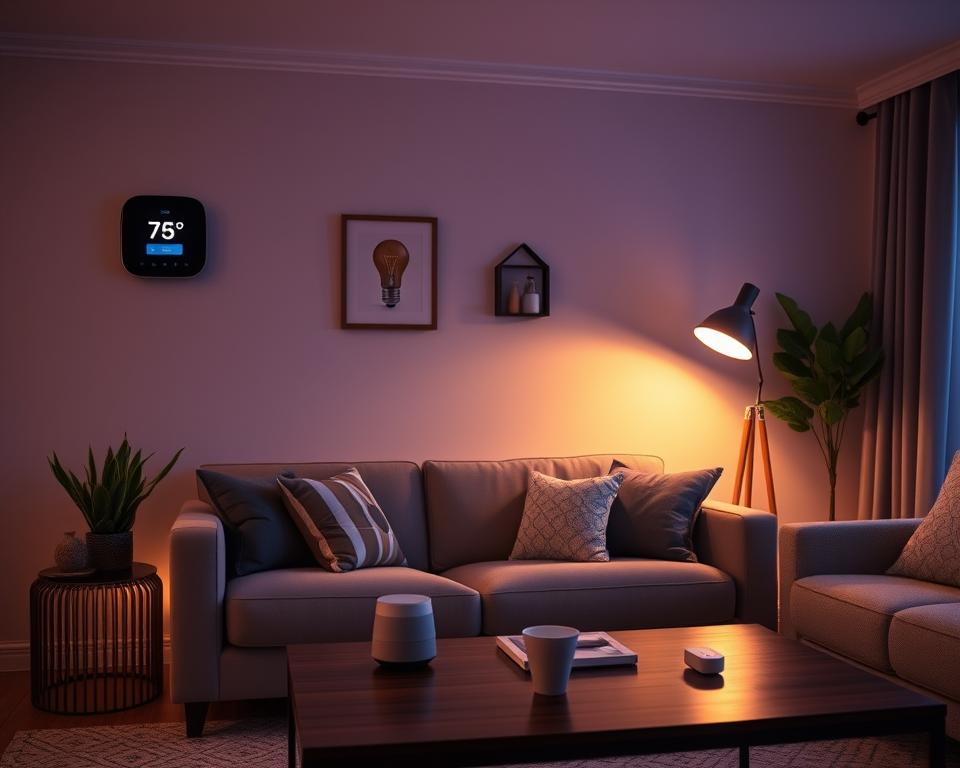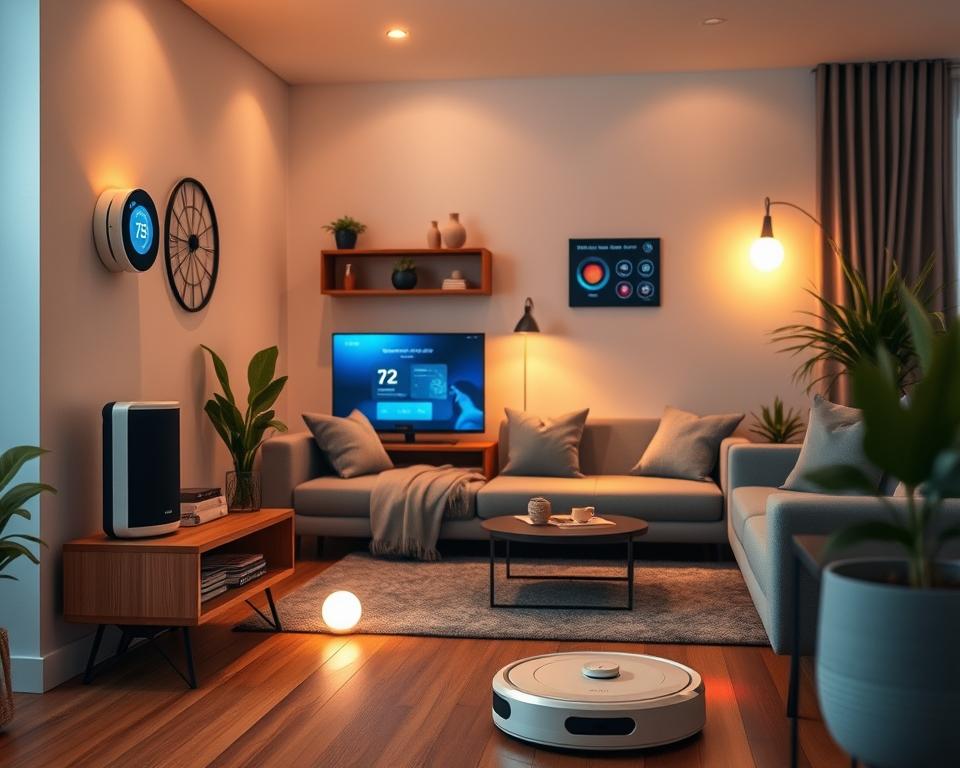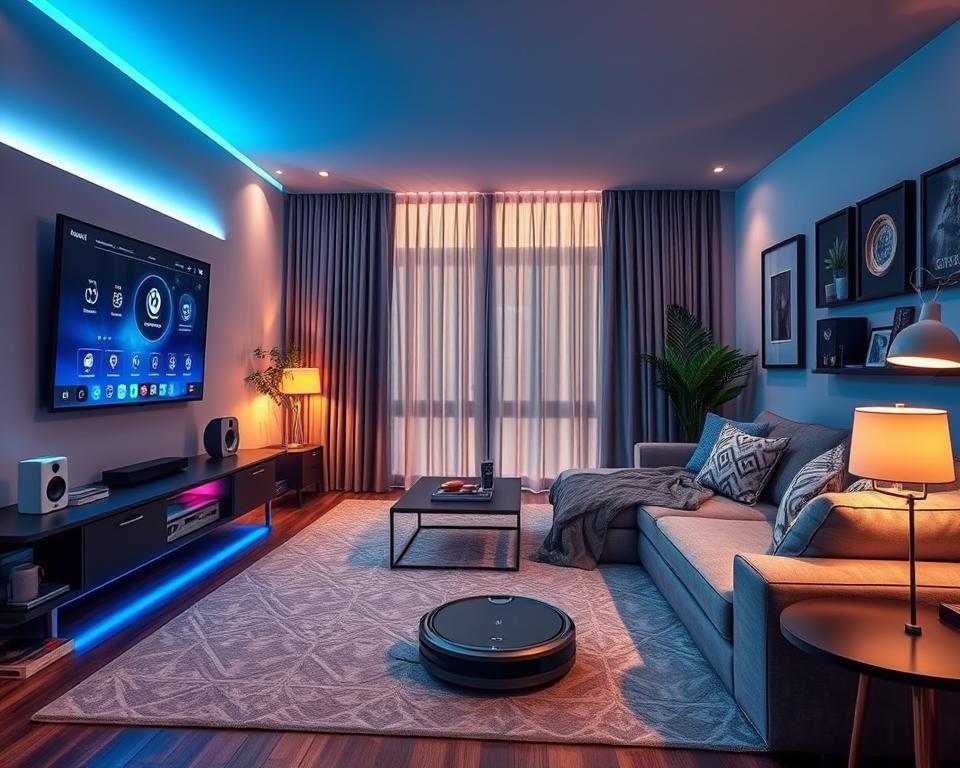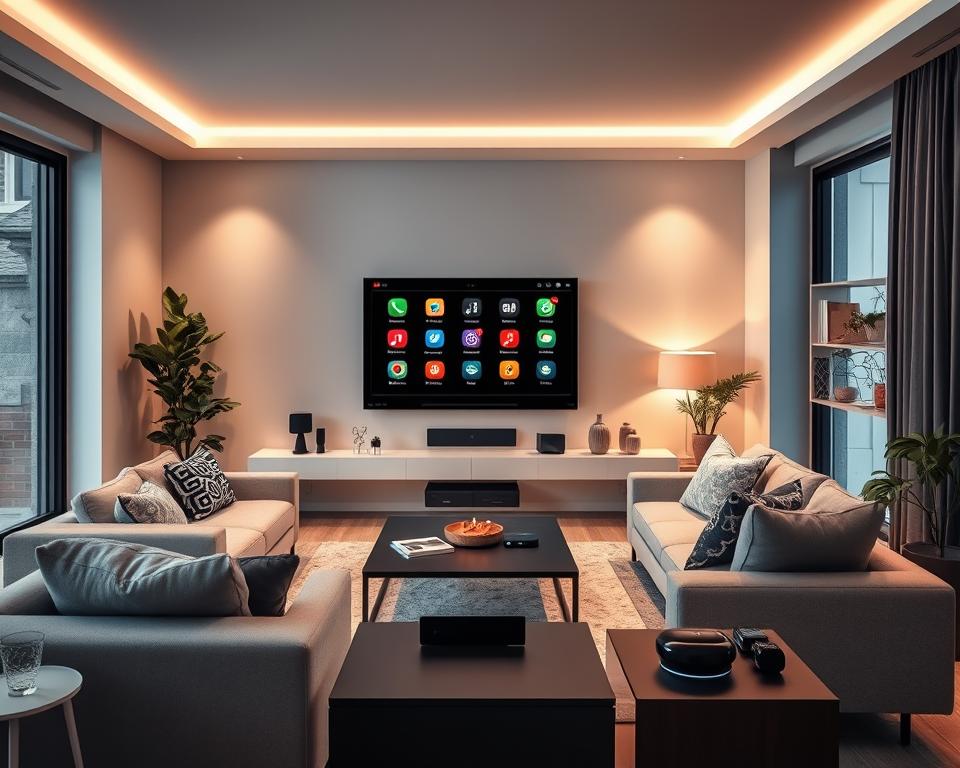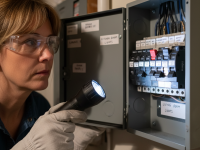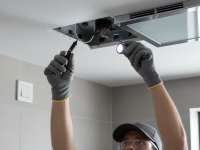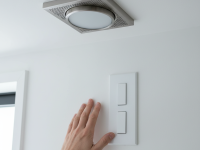Overwhelmed by Smart Home Tech? Here’s Your Beginner-Friendly Guide to Automation!
Are you curious about making your home smart but feel a bit lost? Don’t worry, this guide is here to help. It’s perfect for both tech-savvy homeowners and those just starting out.
A modern living room filled with sleek smart home devices, featuring a high-tech touchscreen control panel, automated smart lighting casting soft ambient colors, a robotic vacuum gliding across the floor, and smart speakers integrated into stylish decor, all within a cozy and inviting atmosphere.
The world of smart home tech can seem overwhelming. But don’t worry, we’ve got you covered. This guide will introduce you to the basics, recommend devices, and show you how to set them up. You’ll learn how to make your home smarter and more comfortable.
Key Takeaways
- Discover the core components of smart home technology and what makes a home “smart”
- Explore the benefits of smart home integration and how it can simplify your daily routines
- Learn how to get started with smart home automation, from selecting the right devices to setting up your first smart home hub
- Master voice control with popular virtual assistant platforms and troubleshoot common issues
- Discover budget-friendly smart home solutions and energy-saving automation tips
- Understand the importance of smart home security and privacy considerations
- Create custom automation routines to truly personalize your intelligent living space
Ready to make your home smarter? Let’s start this journey together and explore the world of smart home automation!
Understanding the Basics of Smart Home Technology
Getting into smart home automation can feel like a big task. But once you learn the basics, you’ll see how easy it makes life. Smart home tech turns your home into a smart, responsive space that meets your needs.
What Makes a Home “Smart”?
Smart homes use devices and systems that work together smoothly. This includes voice assistants, smart plugs, and connected lights and security. These tools let you control your home easily, from setting the thermostat to locking doors, just by tapping a button or speaking.
Core Components of Home Automation
- Smart hubs or controllers: These devices are the main control center. They let you manage all your smart home devices from one place.
- Smart devices: These include appliances, lights, security cameras, and thermostats. You can control them with your phone or voice.
- Automation software and apps: These tools help you set up routines and schedules for your home. They make your home work for you.
Benefits of Smart Home Integration
Smart home tech offers many benefits for your daily life. It makes tasks easier, saves energy, and boosts security. Plus, it lets you keep an eye on your home from anywhere, anytime.
| Benefit | Description |
|---|---|
| Convenience | Automate tasks like turning on lights or adjusting the thermostat with voice or phone controls. |
| Energy Efficiency | Save energy by automatically adjusting temperature, lights, and appliances based on your habits and schedule. |
| Security | Use smart security systems, like cameras and motion sensors, for a safer home. You can also access them remotely. |
Exploring smart home automation opens up new ways to simplify your life. It makes your home more connected, efficient, and secure. With the right tools and a bit of exploration, you’ll become a pro at smart home tech.
Smart Home Automation for Beginners: Getting Started
Starting your smart home journey is exciting, but it’s important to do it step by step. First, figure out what you need for your home and how much you can spend. Looking for affordable home automation solutions helps make your dream smart home a reality without spending too much.
Think about which parts of your home could use automation the most. Do you want to save energy, improve security, or make daily tasks easier? Knowing what you need helps you choose the right smart home devices.
- Make a list of the features you can’t live without.
- Find devices that work well together.
- Set a budget and look for affordable options.
For diy home automation, there are many easy and cheap options. Smart plugs, voice assistants, and smart lights are great for beginners. They’re easy to set up and fit well with your home.
“The beauty of smart home automation is that you can start small and gradually expand your system as your needs and budget allow.”
Building a fully automated home doesn’t have to be hard. Just take it one step at a time. Enjoy making your home more efficient, convenient, and connected.
| Feature | Benefit |
|---|---|
| Remote Control | Ability to manage your home from anywhere, providing convenience and peace of mind. |
| Automated Scheduling | Streamline your daily routines and reduce energy consumption with programmed schedules. |
| Voice Activation | Hands-free control of your smart home devices, enhancing accessibility and ease of use. |
Essential Smart Home Devices for First-Time Users
Entering the smart home world can be thrilling but also overwhelming for newcomers. Yet, with the right gadgets, you can turn your home into a place of ease and efficiency. Let’s look at the key smart home devices that will simplify your life and connect you better.
Voice Assistants and Smart Speakers
Voice assistants like Amazon Alexa and Google Assistant are key for many smart homes. They let you manage your home with just your voice. You can set timers, alarms, play music, and control smart lighting easily. They’re a great starting point for exploring voice assistants and smart speakers.
Smart Plugs and Switches
Smart plugs and switches are crucial for a beginner-friendly smart home. They let you control and automate your home’s electronics, like lamps and appliances. With a few taps on your phone, you can turn devices on or off, set schedules, or check energy use.
Connected Lighting Solutions
Changing your home’s mood is easy with smart lighting solutions. Smart bulbs and fixtures let you adjust brightness, color, and temperature. This creates the perfect mood for any time, whether relaxing or partying.
“With the right smart home devices, you can transform your living space into a seamless, connected environment that enhances your daily life.”
Adding these essential smart home devices is the first step to a more automated and convenient life. Discover the power of voice assistants, smart plugs, and connected lighting to open up new possibilities in your home.
Setting Up Your First Smart Home Hub
For those new to smart home automation, setting up a central hub is crucial. This hub acts as the brain of your automated home. It lets you manage all your smart home automation for beginners and home automation apps from one place.
Popular hubs include Samsung SmartThings, Apple HomeKit, and Amazon Alexa. These hubs offer features like voice control and remote access. When picking your first hub, think about device compatibility, app ease, and ecosystem integration.
- Check if your devices work with your chosen hub.
- Download the app and create an account to start.
- Follow the hub’s setup steps to connect your devices and set your home’s settings.
- Discover the hub’s automation features to make your home more efficient.
With your hub set up, you can control lights, appliances, and security from your hand or voice. Enjoy the ease of smart home automation for beginners and make your home smarter.
“A smart home hub is the heart of a connected home, bringing all your devices together for seamless control and automation.”
Voice Control: Mastering Smart Home Commands
Voice assistants and smart speakers have changed how we interact with our homes. Using this technology can make your home more convenient and efficient. Let’s explore the top voice assistant platforms, essential commands, and how to fix any voice control problems.
Popular Voice Assistant Platforms
The top voice assistants are Amazon Alexa, Google Assistant, and Apple Siri. Each has unique features and works with many smart home devices. Choose the one that fits your needs and preferences best.
Basic Voice Commands to Know
- Turn on/off smart lights and appliances
- Adjust thermostats and climate control
- Play music and audio content
- Set timers and alarms
- Retrieve information and news updates
- Control smart home security systems
Troubleshooting Voice Control Issues
Even with voice control, you might face some issues. Problems like poor audio, device connection issues, and misunderstood commands can happen. Here are some tips to keep your voice-controlled home running smoothly:
- Check the microphone and speaker quality of your voice assistant device
- Ensure your smart home devices are properly connected to the network
- Speak clearly and avoid background noise when issuing commands
- Customize your voice assistant’s name recognition and settings
- Refer to the manufacturer’s guidance for specific troubleshooting steps
| Voice Assistant Platform | Key Features | Compatibility |
|---|---|---|
| Amazon Alexa | – Wide range of smart home integrations – Music playback and audiobook support – Extensive voice command library |
– Supports a vast ecosystem of smart home devices – Integrates with Amazon’s own products and services |
| Google Assistant | – Natural language processing – Google search and information access – Integration with Google’s suite of apps and services |
– Works with a growing number of smart home devices – Seamless integration with Android and Google-powered products |
| Apple Siri | – Tight integration with Apple’s ecosystem – Multitasking and device control capabilities – Personalized user experience |
– Primarily focused on Apple’s own smart home products – Limited compatibility with third-party smart devices |
By learning the essential voice commands and understanding different voice assistants, you can fully enjoy your smart home. It’s all about hands-free living.
Budget-Friendly Smart Home Solutions
Automating your home doesn’t have to be expensive. There are many affordable home automation solutions and DIY home automation options. These can make your home smarter without costing a lot. Let’s look at some ways to make your home smart without spending too much.
Home Assistant is a great, low-cost smart home platform. It’s open-source, which means you can connect lots of devices and make your own routines. You can start small and add more as you can afford it.
- Find smart home kits that include important devices like smart plugs, lights, and sensors. They’re a good way to begin.
- Try DIY projects with low-cost tools like Raspberry Pi or Arduino. They let you create your own smart home solutions.
- Look for sales and discounts on smart home gadgets. They often happen during holidays and special events.
You don’t need to automate your whole home at once. Start with something like lighting or temperature control. Then, add more as you can. This way, you can enjoy smart home benefits without spending too much.
“The key to building a budget-friendly smart home is to start small, research thoroughly, and invest in versatile, open-source platforms that allow for gradual expansion.”
Smart Security: Protecting Your Automated Home
When you start with smart home automation, keeping your devices safe is key. It’s important to protect your home and family with smart technology. We’ll look at the main security parts, how to set up monitoring, and privacy tips.
Essential Security Components
Creating a strong smart security system needs the right devices. Smart doorbells, security cameras, and smart locks are the basics. These smart security systems let you watch over your home, control who comes in, and get alerts on your phone.
Setting Up Monitoring Systems
Having a full home monitoring system is key for a secure beginner’s guide to home automation. Look for systems with motion detection, cloud storage, and remote access. Setting them up might take some work, but the safety they offer is worth it.
Privacy Considerations
Smart home tech has many benefits, but privacy is crucial. Check how your smart security systems handle your data. Know how your info is used and protect it by using two-factor authentication and limiting access.
Creating Custom Automation Routines
Unlock your smart home’s full potential with custom automation routines. No more juggling apps and devices. With the right tools, you can create personalized sequences that work together smoothly. Whether you’re new to smart home automation for beginners or a tech expert, home automation apps can make your life simpler.
Imagine waking up to your blinds opening, coffee brewing, and the thermostat adjusting with just a voice command or app tap. Custom automation routines make this possible, and it’s simpler than you think.
Automating Your Everyday Routines
Apps like IFTTT, Apple Home, and Google Home make creating custom routines easy. Even if you’re not tech-savvy, these platforms let you connect devices and set up triggers. Your home becomes a well-oiled machine.
- Set your lights to turn on at sunset and off at bedtime
- Automatically lock your doors and arm your security system when you leave the house
- Have your smart speakers play your favorite morning playlist as you start your day
- Receive alerts when motion is detected in specific areas of your home
The possibilities are endless. With a bit of creativity, you can make your daily tasks easier and have more time for what’s important.
The secret to great custom automation is finding the right balance. Try different routines, fix any problems, and adjust your settings until it fits your life perfectly.
Smart Home Energy Management and Savings
Discover how smart home tech can change your energy use and save you money. With the right tools, you can control your home’s temperature, watch your energy use, and save money. Plus, you’ll help the planet too.
Temperature Control Optimization
Smart thermostats have changed how we control our home’s temperature. They work with your smart home to adjust heat and cool based on your schedule and preferences. Brands like Nest, Ecobee, and Honeywell can cut your energy bills by up to 30%.
Energy Monitoring Tools
Get to know how much energy your home uses with smart monitoring tools. Apps like Sense and Neurio show you your electricity use in real time. This lets you find out which appliances use the most energy and make changes to save.
Cost-Saving Automation Tips
Use smart home tech to save money easily. Set your smart plugs and switches to turn off devices when not in use. Schedule your lights to turn on and off when you need them. These small steps can make a big difference in your energy bills.
FAQ
What are the core components of a smart home?
A smart home has key parts like voice assistants and smart plugs. It also includes connected lighting and security systems. A central hub ties everything together, controlling all devices.
How can I get started with smart home automation on a budget?
Starting a smart home on a budget is easy. Look for affordable smart plugs and lighting. Open-source platforms like Home Assistant offer great automation without costing much.
How do I set up voice control in my smart home?
Use Amazon Alexa, Google Assistant, or Apple Siri for voice control. First, set up a compatible smart speaker or hub. Then, connect your devices and learn basic voice commands.
What are the key benefits of integrating smart home technology?
Smart home tech brings many benefits. It makes life easier, saves energy, and boosts security. It also lets you create routines for a more comfortable life.
How can I ensure my smart home is secure and protects my privacy?
Keep your smart home safe by using smart locks and cameras. Be careful with your data and privacy. Check the security of your devices and use privacy features.
Can smart home technology help me save on energy costs?
Yes, it can! Smart homes save energy with smart thermostats and monitoring tools. They also help you automate savings. This way, you can cut down on bills and help the planet.
